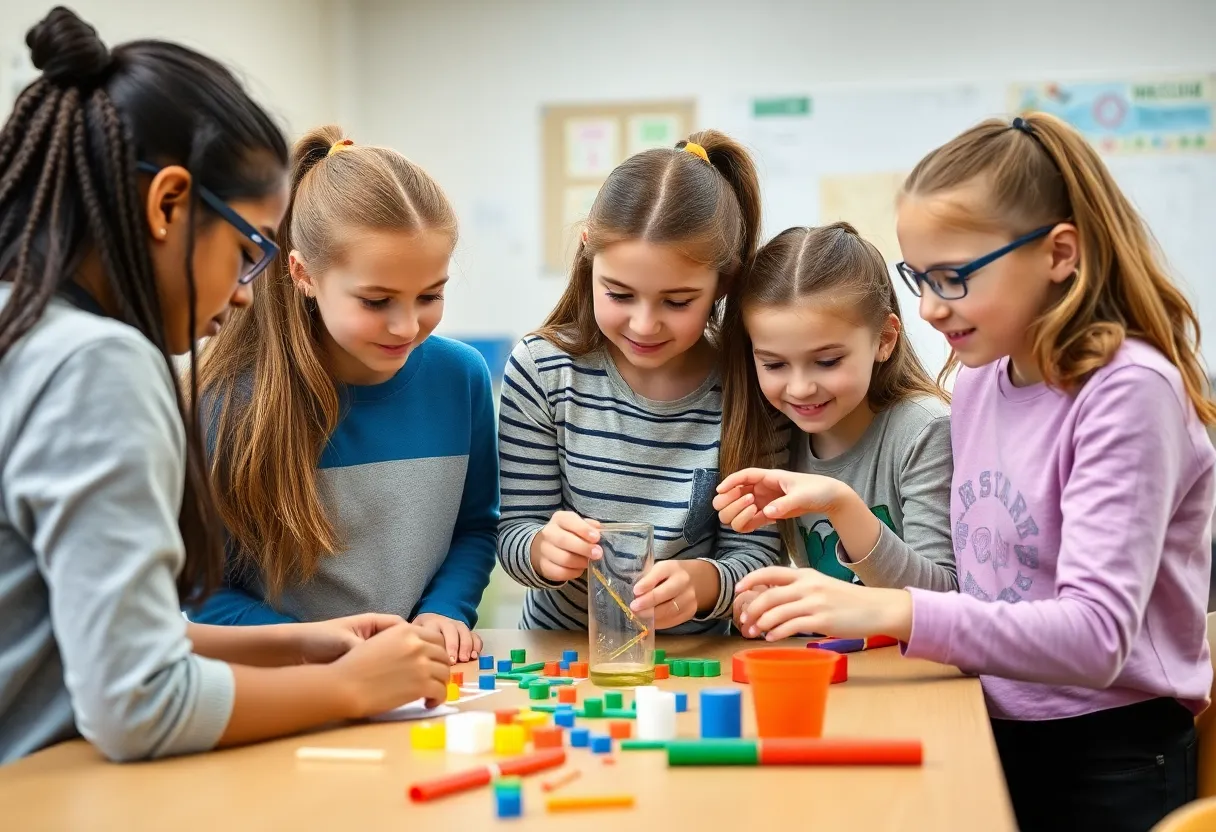Dallas, September 8, 2025
News Summary
Local schools in Dallas are prioritizing initiatives to counter a decline in girls’ participation in STEM education, particularly following the pandemic. With strategies such as curriculum changes, teacher retraining, and earlier exposure to STEM topics, schools aim to engage more middle school girls. Data reveals a significant drop in girls’ math and science performance post-COVID, but programs supporting hands-on learning and balanced class compositions have shown success, with many participants continuing in STEM fields in college. Community support and targeted outreach are vital to restoring gender equity in education.
Dallas — Efforts to reverse a pandemic-driven decline in girls’ participation and performance in science, technology, engineering and math (STEM) education are gaining momentum in local schools and programs, fueled by curriculum changes, teacher retraining and targeted outreach to middle school girls.
Key developments and immediate impact
At de Zavala Middle School in Dallas, four sixth-grade girls observed a Lego-based machine respond differently to colored cards during a hands-on lesson, an example of the practical STEM learning the school is emphasizing in its first year as a choice STEM campus. The sixth-grade cohort is 50% girls, reflecting school leadership goals to boost early engagement so more girls choose elective STEM courses in higher grades.
Across districts, data show that girls lost ground in both interest and performance in math and science after the COVID-19 pandemic. A national analysis of recent academic results found that boys had higher average math scores than girls in roughly 90% of school districts in the 2023–2024 school year. The pandemic’s shift to remote learning is cited as a major factor, with changes in instruction and added out-of-class responsibilities affecting girls disproportionately.
Why leaders are acting now
Educators and program directors are prioritizing early-grade STEM exposure, balanced class composition and teacher training because pre-pandemic gains — when girls’ math performance had largely caught up with boys — have eroded. Schools that moved STEM content into earlier grades and intentionally balanced class gender composition reported higher engagement among girls. Teacher retraining initiatives are underway in some districts to restore and improve teaching practices that support girls’ learning styles.
Programmatic responses
A long-standing regional program that serves middle school girls has demonstrated measurable success: more than 1,300 underrepresented girls participated in the program, and about 85% of those participants continued to major in STEM fields in college. The program emphasizes hands-on learning, leadership, service projects and soft skills such as résumé writing and professional networking, while also focusing on support for first-generation students and mentoring to help overcome barriers at home.
Factors behind the decline and recovery strategies
Several intersecting factors contributed to the setback for girls in STEM during the pandemic. Remote learning often prioritized rote instruction, memorization and competitive formats over problem-solving and flexible thinking—teaching approaches that had previously favored girls’ preferred learning styles. Reports also indicate increased anxiety among girls around math and science subjects during the pandemic and greater caretaking responsibilities that reduced time for academic work.
Recovery strategies now emphasize restoring inquiry-based learning, collaborative problem-solving and resilience-building across subjects. Districts report that hands-on activities, earlier exposure to engineering and technology concepts, and balanced enrollment in elective classes help sustain girls’ interest. Investments in teacher training aim to reintroduce student-centered methods and counteract long-standing biases that can appear during times of disruption.
Local examples and institutional support
In the Dallas-Fort Worth area, schools and community programs have taken coordinated steps: a middle school STEM choice campus with gender-balanced sixth-grade classes, district-level curriculum realignments to introduce STEM earlier, and targeted summer programs for girls. One recognized mentoring program received local civic acknowledgment and national-level recognition for excellence in STEM mentoring, reflecting community and institutional backing.
Background and broader context
Before the pandemic, many districts saw girls’ math achievement reach parity with or exceed that of boys in some places. By 2022, assessments indicated girls were falling behind again in math and science even as reading skills remained strong. The pandemic’s abrupt shift in education delivery methods revealed how sensitive gender equity outcomes are to instructional design and support systems.
Experts and educators emphasize that reversing the setback requires combining curriculum changes, skill-building opportunities and mentoring with an emphasis on equitable classroom practices. Programs that integrate leadership development, hands-on STEM challenges and sustained mentorship aim to build confidence and create networks of support that carry students from middle school into college and careers.
What to watch next
Key indicators to monitor include enrollment trends in elective STEM courses in middle and high school, future assessment scores in math and science by gender, and college major selections among program alumni. District and program leaders are tracking whether early intervention and sustained mentoring will translate into long-term increases in girls pursuing STEM education and careers.
FAQ
Why did girls fall behind in STEM during the pandemic?
Girls experienced greater disruption from remote learning that often emphasized rote methods over problem-solving. Increased anxiety around math and science and added caretaking responsibilities for some girls also contributed to declines in performance and engagement.
What local actions are being taken to encourage girls in STEM?
Local actions include making STEM a choice focus at middle schools with gender-balanced classes, moving STEM content into earlier grades, investing in teacher retraining for inquiry-based instruction, and running targeted camps and mentoring programs for middle school girls.
Do targeted STEM programs show results?
Yes. A regional program serving over 1,300 underrepresented girls reports that about 85% of participants continued to major in STEM fields in college, and program graduates benefit from hands-on learning, leadership development and mentorship networks.
How can parents and schools support girls’ STEM interest?
Support approaches include encouraging hands-on projects, promoting collaborative and problem-solving classroom activities, offering mentorship and role models, and reducing barriers by providing information and resources for first-generation students and families.
Key features at a glance
Deeper Dive: News & Info About This Topic
HERE Resources
Nomination Period Opens for The Innovation Awards
OTO Development Acquires Hyatt House Dallas/Uptown
Controversy Surrounds Cedar Hill School Educator’s Dismissal
Dallas Schools Achieve Top Rankings in Texas Education
BioNTX Announces 2025 Rising Stars for iC³ Summit
Charitable Organizations in North Texas Report Major Funding Losses
Texas Legislative Session Addresses Child Care Crisis
Fort Worth Schools Facing State Intervention Over Proficiency Issues
Dallas Schools Excel in National Rankings for Academics
New Binational Auto Industry Initiative Launched
Additional Resources
- Dallas Innovates: How a Dallas Nonprofit is Launching Girls into STEM
- Wikipedia: STEM
- Lenovo News: Empowering Boys & Girls Clubs of America in STEM Education
- Google Search: STEM Education for Girls
- NBC DFW: Cosmetic Chemistry Class Exposes Girls to STEM Careers
- Google Scholar: Impact of STEM Education on Girls
- Dallas News: Dallas African American Museum Founder Honored for Girls in STEM
- Encyclopedia Britannica: STEM Education
- Dallas Weekly: Black to the Lab Cosmetic Activity Set
- Google News: Girls STEM Initiatives

Author: STAFF HERE DALLAS WRITER
The DALLAS STAFF WRITER represents the experienced team at HEREDallas.com, your go-to source for actionable local news and information in Dallas, Dallas County, and beyond. Specializing in "news you can use," we cover essential topics like product reviews for personal and business needs, local business directories, politics, real estate trends, neighborhood insights, and state news affecting the area—with deep expertise drawn from years of dedicated reporting and strong community input, including local press releases and business updates. We deliver top reporting on high-value events such as the State Fair of Texas, Deep Ellum Arts Festival, and Dallas International Film Festival. Our coverage extends to key organizations like the Dallas Regional Chamber and United Way of Metropolitan Dallas, plus leading businesses in telecommunications, aviation, and semiconductors that power the local economy such as AT&T, Southwest Airlines, and Texas Instruments. As part of the broader HERE network, including HEREAustinTX.com, HERECollegeStation.com, HEREHouston.com, and HERESanAntonio.com, we provide comprehensive, credible insights into Texas's dynamic landscape.





